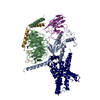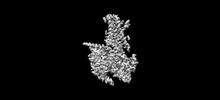Entry Database : EMDB / ID : EMD-33995Title apo-ADGRG2 coupled to Gs apo-ADGRG2-Gs complex Complex : apo-ADGRG2-Gs complexComplex : Guanine nucleotide-binding protein GsProtein or peptide : Guanine nucleotide-binding protein G(s) subunit alpha isoforms shortProtein or peptide : Guanine nucleotide-binding protein G(I)/G(S)/G(T) subunit beta-1Protein or peptide : Guanine nucleotide-binding protein G(I)/G(S)/G(O) subunit gamma-2Complex : Nano-body 35Protein or peptide : Nano-body 35Complex : Adhesion G-protein-coupled receptor G2Protein or peptide : Adhesion G-protein coupled receptor G2 / Function / homology Function Domain/homology Component
/ / / / / / / / / / / / / / / / / / / / / / / / / / / / / / / / / / / / / / / / / / / / / / / / / / / / / / / / / / / / / / / / / / / / / / / / / / / / / / / / / / / / / / / / / / / / / / / / / / / / / / / / / / / / / / / / / / / / / / / / / / / / / / / / / / / / / / / / / / / / / / / / / / / / Biological species Homo sapiens (human) / Lama glama (llama) / Mus musculus (house mouse)Method / / Resolution : 3.1 Å Liu ZM / Bu RQ / Xue CY / Guo SC / Yuan DP / Xiao P / Sun JP Funding support Organization Grant number Country National Science Foundation (NSF, China) 81822008 National Science Foundation (NSF, China) 32000850
Journal : Nat.Chem.Biol. / Year : 2022Title : apo-ADGRG2 coupled to GsAuthors : Liu ZM / Bu RQ / Xue CY / Guo SC / Yuan DP / Xiao P / Sun JP History Deposition Aug 2, 2022 - Header (metadata) release Aug 24, 2022 - Map release Aug 24, 2022 - Update Jul 2, 2025 - Current status Jul 2, 2025 Processing site : PDBj / Status : Released
Show all Show less
 Open data
Open data Basic information
Basic information
 Map data
Map data Sample
Sample Keywords
Keywords Function and homology information
Function and homology information Homo sapiens (human) /
Homo sapiens (human) / 

 Authors
Authors China, 2 items
China, 2 items  Citation
Citation Journal: Nat.Chem.Biol. / Year: 2022
Journal: Nat.Chem.Biol. / Year: 2022 Structure visualization
Structure visualization Downloads & links
Downloads & links emd_33995.map.gz
emd_33995.map.gz EMDB map data format
EMDB map data format emd-33995-v30.xml
emd-33995-v30.xml emd-33995.xml
emd-33995.xml EMDB header
EMDB header emd_33995.png
emd_33995.png emd-33995.cif.gz
emd-33995.cif.gz emd_33995_half_map_1.map.gz
emd_33995_half_map_1.map.gz emd_33995_half_map_2.map.gz
emd_33995_half_map_2.map.gz http://ftp.pdbj.org/pub/emdb/structures/EMD-33995
http://ftp.pdbj.org/pub/emdb/structures/EMD-33995 ftp://ftp.pdbj.org/pub/emdb/structures/EMD-33995
ftp://ftp.pdbj.org/pub/emdb/structures/EMD-33995 emd_33995_validation.pdf.gz
emd_33995_validation.pdf.gz EMDB validaton report
EMDB validaton report emd_33995_full_validation.pdf.gz
emd_33995_full_validation.pdf.gz emd_33995_validation.xml.gz
emd_33995_validation.xml.gz emd_33995_validation.cif.gz
emd_33995_validation.cif.gz https://ftp.pdbj.org/pub/emdb/validation_reports/EMD-33995
https://ftp.pdbj.org/pub/emdb/validation_reports/EMD-33995 ftp://ftp.pdbj.org/pub/emdb/validation_reports/EMD-33995
ftp://ftp.pdbj.org/pub/emdb/validation_reports/EMD-33995
 F&H Search
F&H Search Links
Links EMDB (EBI/PDBe) /
EMDB (EBI/PDBe) /  EMDataResource
EMDataResource Map
Map Download / File: emd_33995.map.gz / Format: CCP4 / Size: 52.7 MB / Type: IMAGE STORED AS FLOATING POINT NUMBER (4 BYTES)
Download / File: emd_33995.map.gz / Format: CCP4 / Size: 52.7 MB / Type: IMAGE STORED AS FLOATING POINT NUMBER (4 BYTES) Sample components
Sample components Homo sapiens (human)
Homo sapiens (human)

 Homo sapiens (human)
Homo sapiens (human)
 Homo sapiens (human)
Homo sapiens (human)
 Homo sapiens (human)
Homo sapiens (human)




 Processing
Processing Sample preparation
Sample preparation Electron microscopy
Electron microscopy FIELD EMISSION GUN
FIELD EMISSION GUN
 Movie
Movie Controller
Controller























 Z (Sec.)
Z (Sec.) Y (Row.)
Y (Row.) X (Col.)
X (Col.)





































